Fan Du
PersonaSAGE: A Multi-Persona Graph Neural Network
Dec 28, 2022Abstract:Graph Neural Networks (GNNs) have become increasingly important in recent years due to their state-of-the-art performance on many important downstream applications. Existing GNNs have mostly focused on learning a single node representation, despite that a node often exhibits polysemous behavior in different contexts. In this work, we develop a persona-based graph neural network framework called PersonaSAGE that learns multiple persona-based embeddings for each node in the graph. Such disentangled representations are more interpretable and useful than a single embedding. Furthermore, PersonaSAGE learns the appropriate set of persona embeddings for each node in the graph, and every node can have a different number of assigned persona embeddings. The framework is flexible enough and the general design helps in the wide applicability of the learned embeddings to suit the domain. We utilize publicly available benchmark datasets to evaluate our approach and against a variety of baselines. The experiments demonstrate the effectiveness of PersonaSAGE for a variety of important tasks including link prediction where we achieve an average gain of 15% while remaining competitive for node classification. Finally, we also demonstrate the utility of PersonaSAGE with a case study for personalized recommendation of different entity types in a data management platform.
Bundle MCR: Towards Conversational Bundle Recommendation
Jul 26, 2022



Abstract:Bundle recommender systems recommend sets of items (e.g., pants, shirt, and shoes) to users, but they often suffer from two issues: significant interaction sparsity and a large output space. In this work, we extend multi-round conversational recommendation (MCR) to alleviate these issues. MCR, which uses a conversational paradigm to elicit user interests by asking user preferences on tags (e.g., categories or attributes) and handling user feedback across multiple rounds, is an emerging recommendation setting to acquire user feedback and narrow down the output space, but has not been explored in the context of bundle recommendation. In this work, we propose a novel recommendation task named Bundle MCR. We first propose a new framework to formulate Bundle MCR as Markov Decision Processes (MDPs) with multiple agents, for user modeling, consultation and feedback handling in bundle contexts. Under this framework, we propose a model architecture, called Bundle Bert (Bunt) to (1) recommend items, (2) post questions and (3) manage conversations based on bundle-aware conversation states. Moreover, to train Bunt effectively, we propose a two-stage training strategy. In an offline pre-training stage, Bunt is trained using multiple cloze tasks to mimic bundle interactions in conversations. Then in an online fine-tuning stage, Bunt agents are enhanced by user interactions. Our experiments on multiple offline datasets as well as the human evaluation show the value of extending MCR frameworks to bundle settings and the effectiveness of our Bunt design.
CGC: Contrastive Graph Clustering for Community Detection and Tracking
Apr 05, 2022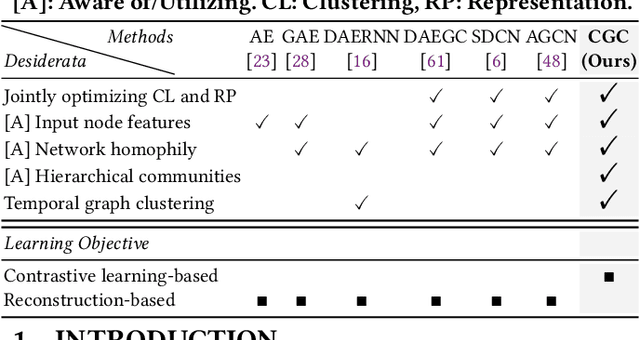

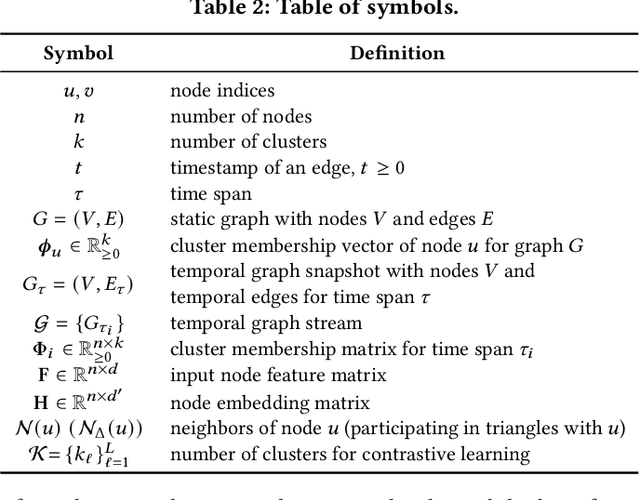
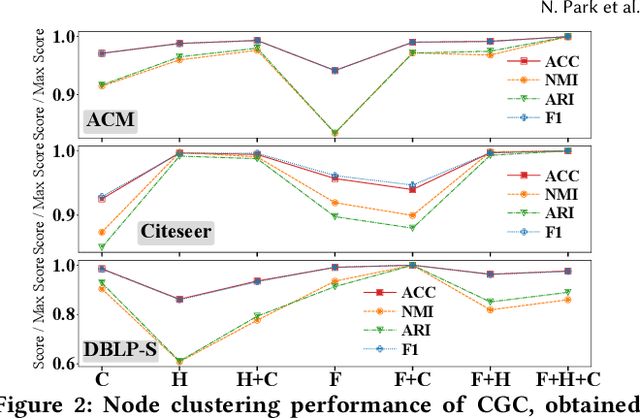
Abstract:Given entities and their interactions in the web data, which may have occurred at different time, how can we find communities of entities and track their evolution? In this paper, we approach this important task from graph clustering perspective. Recently, state-of-the-art clustering performance in various domains has been achieved by deep clustering methods. Especially, deep graph clustering (DGC) methods have successfully extended deep clustering to graph-structured data by learning node representations and cluster assignments in a joint optimization framework. Despite some differences in modeling choices (e.g., encoder architectures), existing DGC methods are mainly based on autoencoders and use the same clustering objective with relatively minor adaptations. Also, while many real-world graphs are dynamic, previous DGC methods considered only static graphs. In this work, we develop CGC, a novel end-to-end framework for graph clustering, which fundamentally differs from existing methods. CGC learns node embeddings and cluster assignments in a contrastive graph learning framework, where positive and negative samples are carefully selected in a multi-level scheme such that they reflect hierarchical community structures and network homophily. Also, we extend CGC for time-evolving data, where temporal graph clustering is performed in an incremental learning fashion, with the ability to detect change points. Extensive evaluation on real-world graphs demonstrates that the proposed CGC consistently outperforms existing methods.
VBridge: Connecting the Dots Between Features, Explanations, and Data for Healthcare Models
Aug 04, 2021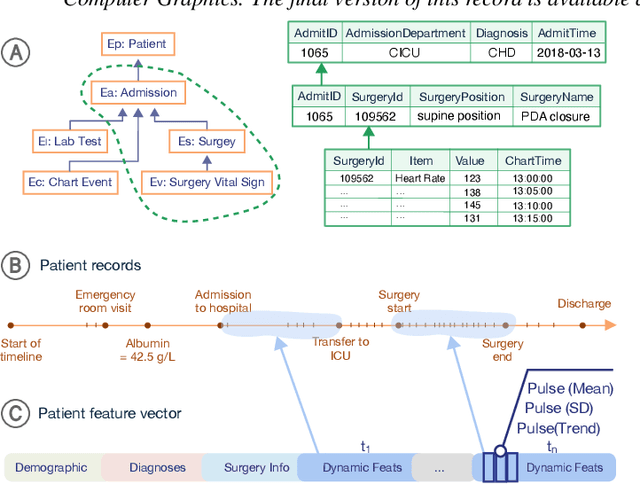
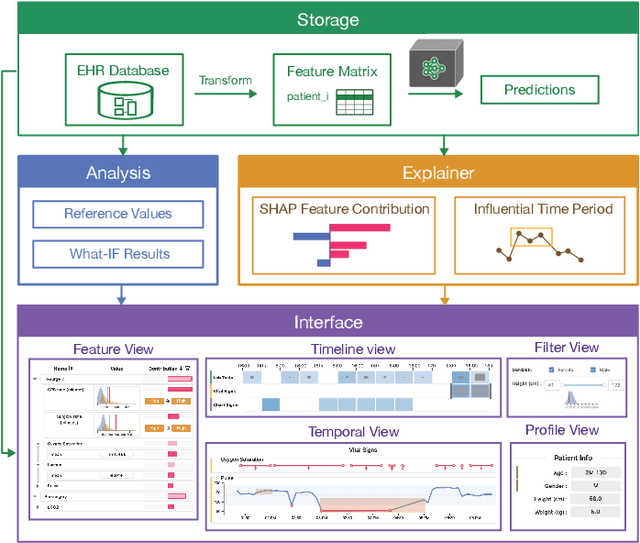
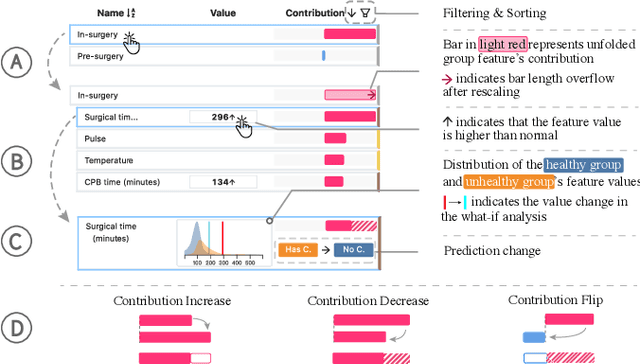
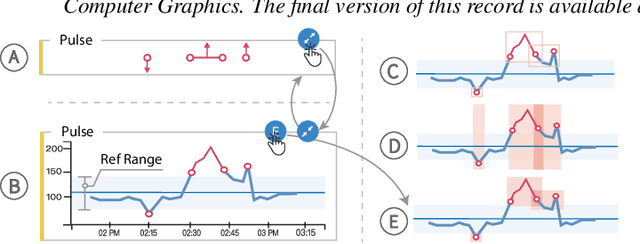
Abstract:Machine learning (ML) is increasingly applied to Electronic Health Records (EHRs) to solve clinical prediction tasks. Although many ML models perform promisingly, issues with model transparency and interpretability limit their adoption in clinical practice. Directly using existing explainable ML techniques in clinical settings can be challenging. Through literature surveys and collaborations with six clinicians with an average of 17 years of clinical experience, we identified three key challenges, including clinicians' unfamiliarity with ML features, lack of contextual information, and the need for cohort-level evidence. Following an iterative design process, we further designed and developed VBridge, a visual analytics tool that seamlessly incorporates ML explanations into clinicians' decision-making workflow. The system includes a novel hierarchical display of contribution-based feature explanations and enriched interactions that connect the dots between ML features, explanations, and data. We demonstrated the effectiveness of VBridge through two case studies and expert interviews with four clinicians, showing that visually associating model explanations with patients' situational records can help clinicians better interpret and use model predictions when making clinician decisions. We further derived a list of design implications for developing future explainable ML tools to support clinical decision-making.
Insight-centric Visualization Recommendation
Mar 21, 2021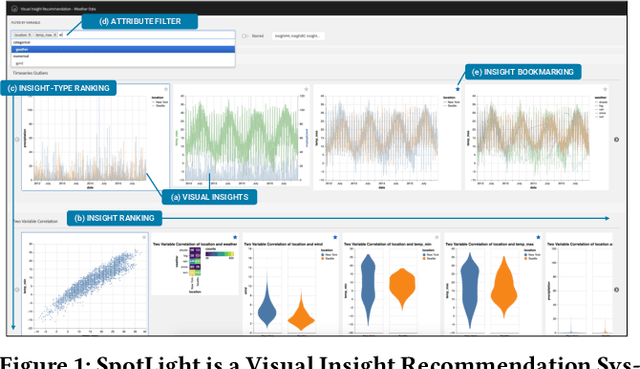
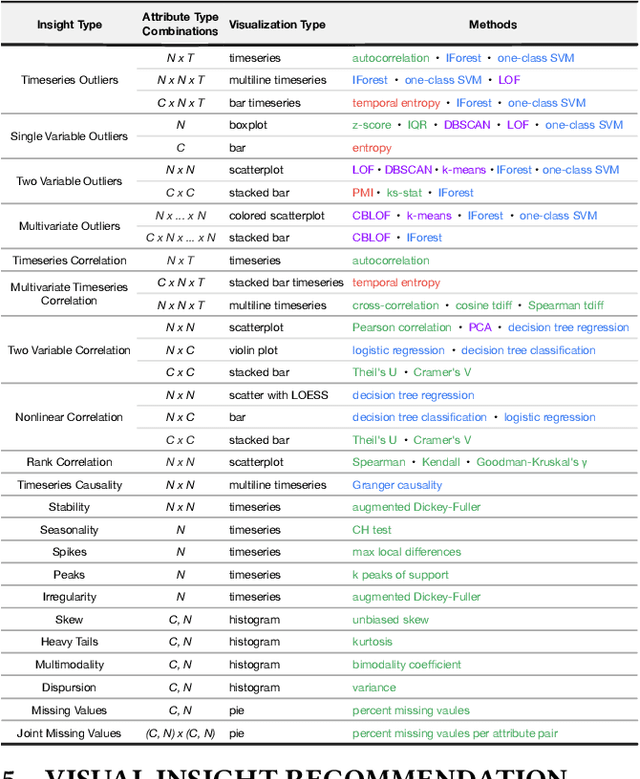

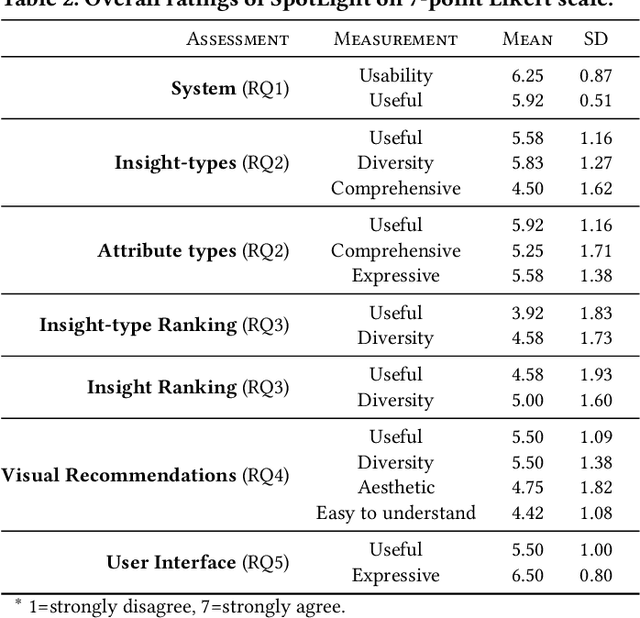
Abstract:Visualization recommendation systems simplify exploratory data analysis (EDA) and make understanding data more accessible to users of all skill levels by automatically generating visualizations for users to explore. However, most existing visualization recommendation systems focus on ranking all visualizations into a single list or set of groups based on particular attributes or encodings. This global ranking makes it difficult and time-consuming for users to find the most interesting or relevant insights. To address these limitations, we introduce a novel class of visualization recommendation systems that automatically rank and recommend both groups of related insights as well as the most important insights within each group. Our proposed approach combines results from many different learning-based methods to discover insights automatically. A key advantage is that this approach generalizes to a wide variety of attribute types such as categorical, numerical, and temporal, as well as complex non-trivial combinations of these different attribute types. To evaluate the effectiveness of our approach, we implemented a new insight-centric visualization recommendation system, SpotLight, which generates and ranks annotated visualizations to explain each insight. We conducted a user study with 12 participants and two datasets which showed that users are able to quickly understand and find relevant insights in unfamiliar data.
Personalized Visualization Recommendation
Feb 12, 2021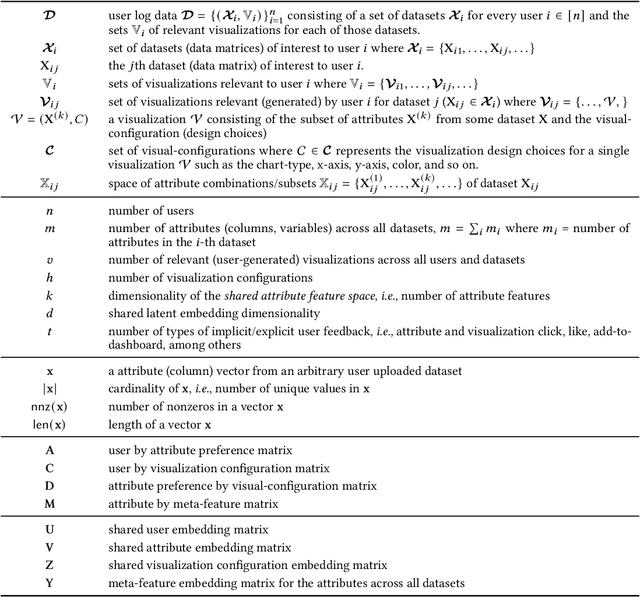
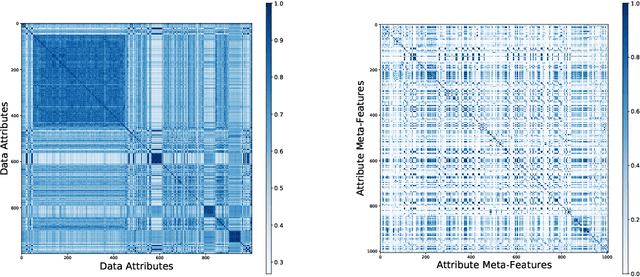

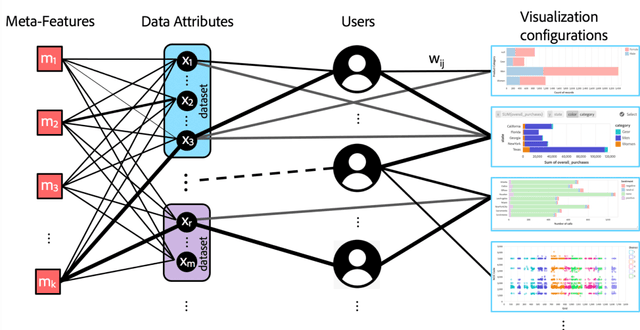
Abstract:Visualization recommendation work has focused solely on scoring visualizations based on the underlying dataset and not the actual user and their past visualization feedback. These systems recommend the same visualizations for every user, despite that the underlying user interests, intent, and visualization preferences are likely to be fundamentally different, yet vitally important. In this work, we formally introduce the problem of personalized visualization recommendation and present a generic learning framework for solving it. In particular, we focus on recommending visualizations personalized for each individual user based on their past visualization interactions (e.g., viewed, clicked, manually created) along with the data from those visualizations. More importantly, the framework can learn from visualizations relevant to other users, even if the visualizations are generated from completely different datasets. Experiments demonstrate the effectiveness of the approach as it leads to higher quality visualization recommendations tailored to the specific user intent and preferences. To support research on this new problem, we release our user-centric visualization corpus consisting of 17.4k users exploring 94k datasets with 2.3 million attributes and 32k user-generated visualizations.
ML-based Visualization Recommendation: Learning to Recommend Visualizations from Data
Sep 25, 2020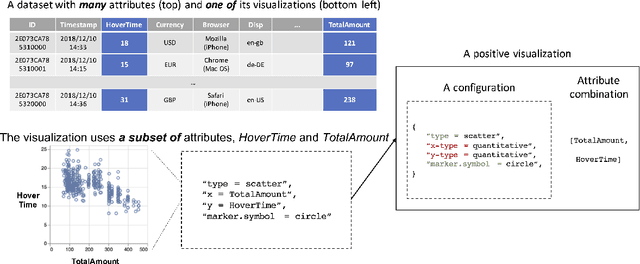
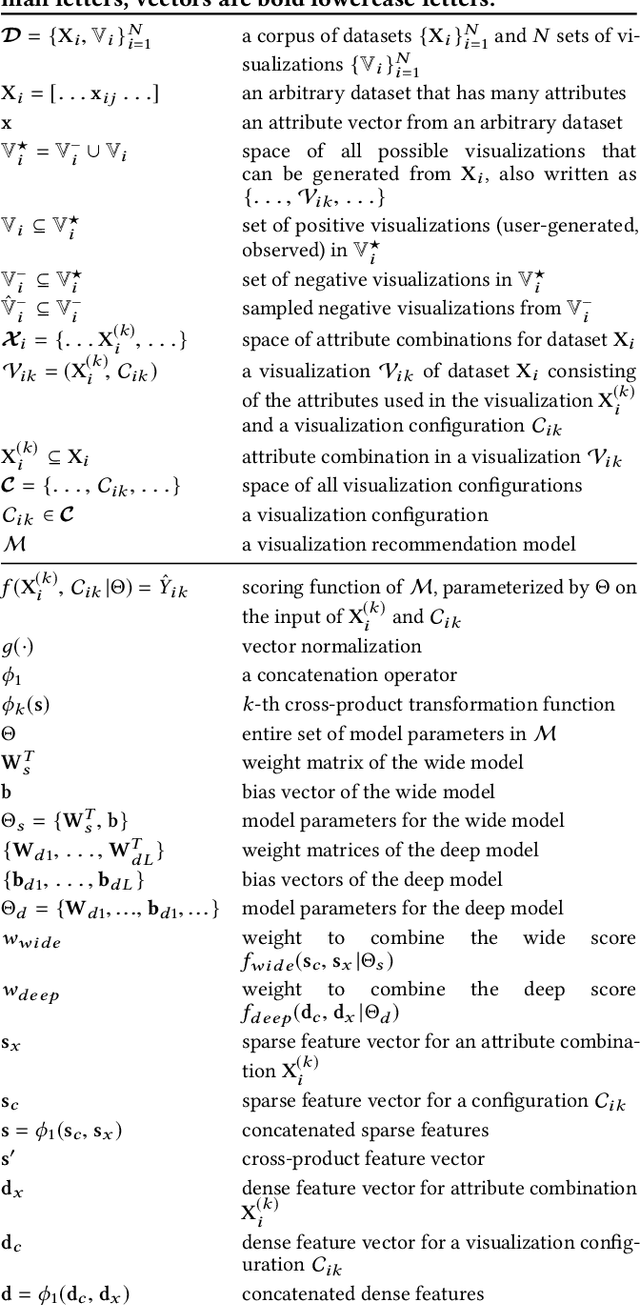
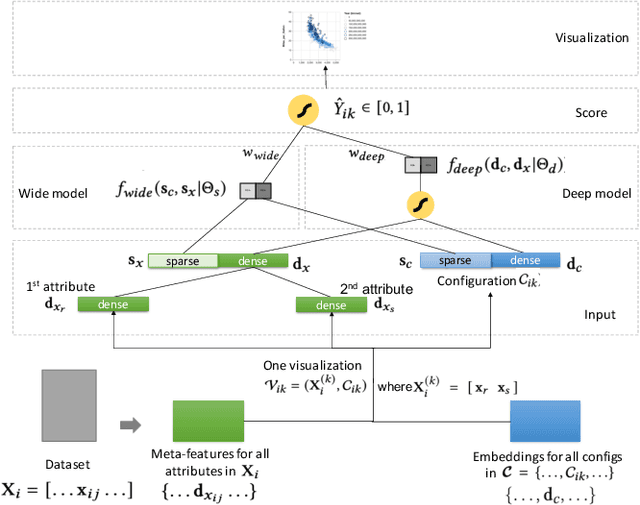

Abstract:Visualization recommendation seeks to generate, score, and recommend to users useful visualizations automatically, and are fundamentally important for exploring and gaining insights into a new or existing dataset quickly. In this work, we propose the first end-to-end ML-based visualization recommendation system that takes as input a large corpus of datasets and visualizations, learns a model based on this data. Then, given a new unseen dataset from an arbitrary user, the model automatically generates visualizations for that new dataset, derive scores for the visualizations, and output a list of recommended visualizations to the user ordered by effectiveness. We also describe an evaluation framework to quantitatively evaluate visualization recommendation models learned from a large corpus of visualizations and datasets. Through quantitative experiments, a user study, and qualitative analysis, we show that our end-to-end ML-based system recommends more effective and useful visualizations compared to existing state-of-the-art rule-based systems. Finally, we observed a strong preference by the human experts in our user study towards the visualizations recommended by our ML-based system as opposed to the rule-based system (5.92 from a 7-point Likert scale compared to only 3.45).
The Impact of Presentation Style on Human-In-The-Loop Detection of Algorithmic Bias
May 09, 2020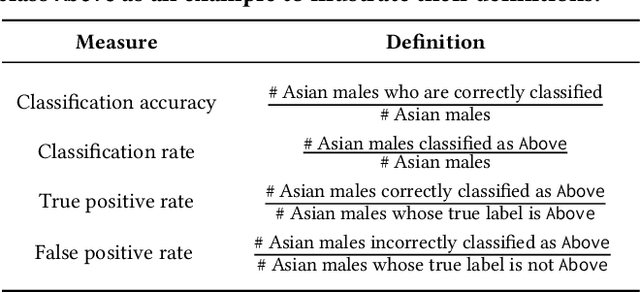



Abstract:While decision makers have begun to employ machine learning, machine learning models may make predictions that bias against certain demographic groups. Semi-automated bias detection tools often present reports of automatically-detected biases using a recommendation list or visual cues. However, there is a lack of guidance concerning which presentation style to use in what scenarios. We conducted a small lab study with 16 participants to investigate how presentation style might affect user behaviors in reviewing bias reports. Participants used both a prototype with a recommendation list and a prototype with visual cues for bias detection. We found that participants often wanted to investigate the performance measures that were not automatically detected as biases. Yet, when using the prototype with a recommendation list, they tended to give less consideration to such measures. Grounded in the findings, we propose information load and comprehensiveness as two axes for characterizing bias detection tasks and illustrate how the two axes could be adopted to reason about when to use a recommendation list or visual cues.
Designing Tools for Semi-Automated Detection of Machine Learning Biases: An Interview Study
Mar 18, 2020Abstract:Machine learning models often make predictions that bias against certain subgroups of input data. When undetected, machine learning biases can constitute significant financial and ethical implications. Semi-automated tools that involve humans in the loop could facilitate bias detection. Yet, little is known about the considerations involved in their design. In this paper, we report on an interview study with 11 machine learning practitioners for investigating the needs surrounding semi-automated bias detection tools. Based on the findings, we highlight four considerations in designing to guide system designers who aim to create future tools for bias detection.
 Add to Chrome
Add to Chrome Add to Firefox
Add to Firefox Add to Edge
Add to Edge